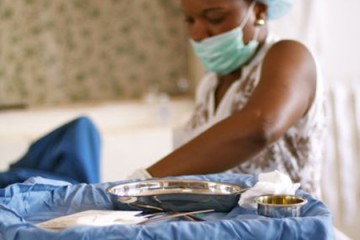A steep drop in the local incidence of new HIV infections coincided with the rollout of a U.S.-funded anti-HIV program in a large East African population, according to a study led by researchers at Johns Hopkins University's Bloomberg School of Public Health and School of Medicine.
The study, published today in the New England Journal of Medicine, is the first to track a large group of people before, during, and after the start of an HIV prevention program and show that the program is likely working on a large scale. The researchers found that as the program began and matured from the early 2000s until 2016, there was a 42 percent decline in the rate of new HIV infections.
The ongoing HIV prevention program—in Uganda's rural Rakai District on the shore of Lake Victoria—is funded by the President's Emergency Plan for AIDS Relief, or PEPFAR, which was set up in 2004 by the George W. Bush administration. The program provides multiple free services, including anti-HIV drugs for infected people, voluntary safe male circumcision, condoms, and promotion of risk-reduction sexual practices. These measures are known to reduce HIV transmission and acquisition at an individual level, but their population-wide impact over time in a real-world context has been less clear.
The African region accounts for almost two-thirds of the global total of new HIV infections, according to the World Health Organization, with 25.6 million people in the region living with HIV in 2016.
"When I started doing research at Rakai in the late 1980s, about a third of people in the trading centers were HIV positive, and there was little we could do to prevent a further spread of the virus," says co-senior author Maria Wawer, a professor in the Bloomberg School. "But now there's so much more that we can do, and with this study we're finally seeing the beneficial results of these combined interventions,"
Rakai District was one of the earliest- and worst-hit areas when the HIV/AIDS pandemic emerged in the 1980s. In 1988, Wawer and Ugandan colleagues founded the Rakai Project—re-named the Rakai Health Sciences Program, or RHSP, as it expanded—and began conducting surveys and HIV testing among adults ages 15 to 49 in Rakai communities. This initial work resulted in the Rakai Community Cohort Study, now one of the largest and oldest HIV surveillance studies tracking the epidemic in sub-Saharan Africa. Scale-up of PEPFAR-funded efforts to reduce HIV mortality and new infections began in the area in 2004.
"The results are exciting because they show that the scale-up of these interventions, including adherence to antiretroviral drugs, is possible and can reduce the rate of new HIV infections even in low-resource settings," says lead author Mary Kate Grabowski, an assistant professor in the School of Medicine with a joint appointment in the Bloomberg School.
The co-senior author of the study was Larry W. Chang, associate professor at Johns Hopkins School of Medicine.
The current study, based on data on 34,000 adults, confirmed the widespread adoption of many of PEPFAR's HIV prevention measures:
- The use of antiretroviral therapy among infected people rose steadily from 12 percent in the 2006 survey to 69 percent in 2016
- The proportion of circumcised men nearly quadrupled, from about 15 percent in 1999 to 59 percent in 2016
- The proportion of HIV-infected people in whom the amount of virus in their blood fell to near zero (at which point transmission is virtually stopped) rose from 42 percent in 2009 to 75 percent in 2016
Evidence of behavioral changes was weaker—the rate of condom use did not rise, for example—but during the study period, younger people in the cohort appeared to become much less likely to initiate sex.
The data also showed that as coverage of the PEPFAR services increased following their introduction in 2004, the incidence of new HIV infections in the cohort—the number of conversions from HIV-negative to HIV-positive status, on a per-person, per-year basis—began to fall. From 1999 to 2006 the average was 1.17 cases per 100 person-years. By 2016 that figure had fallen to 0.66 cases per 100 person-years. With statistical adjustments for the aging of the cohort and other variables, that represents a net decline of 42 percent.
"These findings strongly suggest that at the population level there really is a dose-response effect," Wawer says, "so that the more prevention services are provided, the more the rate of new infections goes down."
She notes that the Rakai prevention program is beginning to expand its services to include pre-exposure prophylaxis: antiretroviral therapy for people who are HIV-negative to protect them from infection if they have sex with people who are HIV-positive.
PEPFAR, which has an annual budget of nearly $7 billion, continues to fund new and existing prevention programs in Africa and other heavily HIV-affected areas. It also funds studies of these prevention programs' impacts.
"Preliminary data from other sites in Uganda and elsewhere are consistent with our encouraging findings from Rakai," Grabowski says.
Posted in Health
Tagged hiv/aids, global health









